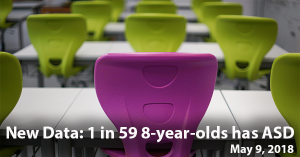Check out other stories from the Latest News
CDC Data Show Increase in Autism Diagnosis
By Chelsea Toledo, M.A. on May 9, 2018

Background: The U.S. Centers for Disease Control and Prevention, or CDC, regularly monitors communities to make estimates of the prevalence of Autism Spectrum Disorder (ASD) among children across the country. In 2016, the CDC estimated ASD prevalence of one in 68 for 8-year-olds based on data collected from 2010 to 2012. Prior to that, the prevalence among 8-year-olds was estimated to be one in 150.
What’s New: The latest CDC data – collected in 2014 – provide a new estimate for the prevalence of ASD among 8-year-old children: one in 59. To arrive at this figure, the researchers reviewed the records of more than 300,000 children in 11 states.
The researchers found:
- The overall prevalence of ASD in 2014 was 16.8 per 1,000 – or one in 59 – in the sites surveyed.
- That proportion provides a rough estimate for autism prevalence in the country; however, the results are not entirely generalizable as they come from only 11 sites.
- The median age at which members of the sample group received an ASD diagnosis was 4 years and 4 months – down slightly from 4 years and 5 months in previous years.
- The ratio of boys to girls receiving ASD diagnoses decreased slightly – from 4.5:1 in 2002-2012 to 4:1 in 2014.
- While white children continue to have higher rates of ASD diagnoses than their black and Hispanic peers, that difference became less pronounced in 2014.
Why it’s important: The continued increase in ASD prevalence among children raises a major concern for clinicians and researchers alike. However, the leveling of diagnosis rates among various groups – boys versus girls, white versus minority children – suggests that ASD diagnosis may be improving among previously underrepresented groups. Further surveillance is needed to determine the factors contributing to ASD prevalence increases.
Help me understand :
| Source(s) : |
| Tweet |

